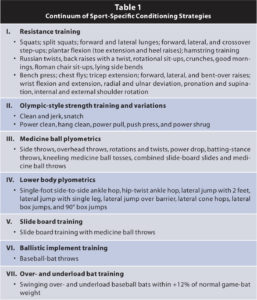Top 7 Hitting Drills And Exercises
This article will be covering the top 10 hitting drills and exercises to help you hit harder, farther, and  more consistently. These are all hitting drills and exercises we use in the GFT Hitting Program. All exercises are the latest in sports science that has been proven by studies to enhance performance. Let's begin!
more consistently. These are all hitting drills and exercises we use in the GFT Hitting Program. All exercises are the latest in sports science that has been proven by studies to enhance performance. Let's begin!
7. Hitting Drills And Exercises - Overload/Underload Bats
Studies have shown overload/underload bats have increased swing velocity by up to 6-10%. They can be used in batting practice, tee work, or dry swings. The variance in weight only needs to be +/- 12% of your in-game bat weight. That means if you swing a standard 30 oz bat your overload would be 34 oz and your underload would be 27 oz. Keep in mind the batting practice group increased their swing velocity by 10% and the dry swing group increased by 6%.
"Overweight and Underweight Integral Training. In this category, both studies reported a significant increase in bat swing velocity after training with overweighted and underweighted bats. In each study, 100 swings per session were taken with the overweighted and underweighted bats. In the study by DeRenne et al., players took 50 additional swings with their standard game bat (30 oz) for a total of 150 swings. There was a 2:1 ratio of overweighted and underweighted bat swings to standard game bat swings. The average bat swing velocity increase reported in these studies ranged from 6–10%. DeRenne et al. used 3 groups: a dry swing, a batting practice, and a control group. The group that took batting practice increased 4% more than the dry swing group. The 10% improvement accomplished by the batting practice group is the most of any bat swing velocity study to date. It was hypothesized that the additional improvement was attributable to actually hitting baseballs with the intent of hitting the baseball hard and/or far. The dry swing group swung their bats through the air without hitting a baseball." (1)
6. Hitting Drills And Exercises - Separation And Hitters Medicine Ball Throw
These sport-specific 2 LB med ball throws are designed to mimic the kinematic sequence and efficiently transfer energy from the ground up through the kinetic chain. Also, it allows you to build rotational power. These drills are huge for increasing your body's ability to maximize the energy transfer into your swing to hit harder and farther!
"Group 2, as expected, made significantly greater increases (10.6%) in the medicine ball hitter’s throw than group 1 because they completed the same stepwise periodized resistance program, took the same number of total bat swings, and performed the additional rotational medicine ball program that included the medicine ball hitter’s throw as part of their training program. Like hitting or pitching, the sequential action of the medicine ball hitter’s throw is dependent on a player’s timing. If executed correctly, optimal transfer of energy from the large base segments (legs, hips, and torso) to the smaller distal segments (shoulders and arms) and finally to the object (bat or ball) that is projected away from the body will occur." (2)
5. Hitting Drills And Exercises - Full Body Ballistic Medicine Ball Routine
Not to be confused with the hitter's throw, the med ball routine uses exercises that aren't as sport-specific but are still beneficial to building a better more powerful hitter. For example, the squat to press, med ball scoop toss, overhead slams, granny toss, etc. do not fully mimic a swing, but they allow you to use heavier med balls 6-12 LBS in a ballistic movement similar in power production to a swing.
"Medicine ball training, which can be described as both ballistic and plyometric, allows baseball players to mimic the powerful, sequential, and rotational actions (e.g., hitting, throwing) that occur during a game. This may allow a hitter to swing a bat with greater velocity. If bat-ball contact occurs with greater bat swing velocity, the ball will travel farther, be hit harder, or both." (2)
4. Hitting Drills And Exercises - Plyometrics
Strength & conditioning coaches have long used plyometrics exercises to bridge the gap between speed & strength. As a stand-alone training program plyometrics benefits are minimal, but when combined with heavy strength training the results are extremely beneficial to developing dynamic leg power. The development of leg power is huge for enhancing your hitting ability.
"As both maximal power and a combined weight + plyometric training program have been reported to be better at enhancing athletic performance than either traditional heavy resistance training or plyometric training alone." (3)
3. Hitting Drills And Exercises - Heavy Resistance Training
Heavy resistance training has long been taboo in baseball for fear of becoming too tight or bulky. Recently, those fears have started to be overcome and coaches/players are realizing the tremendous benefit heavy load training brings to an athlete's on-field performance. Countless studies have shown the benefit of heavy resistance training to athletic performance including jumping, running, throwing, and hitting. Examples of these lifts are bench presses, squats, deadlifts, overhead presses, etc.
"A baseball player’s ability to utilize his body as a kinetic link when performing the rotational movements that occur during a game depends on the interaction of the 3 body (hips, torso, and upper body) segments. Improvements in torso rotational and sequential hip-torso-arm rotational strength in our study may be, in part, related to the improvements in parallel squat (leg) strength. Not only will an increase in leg strength contribute to increased vertical force production but also to rotational force production (torque) about an axis or joint. During the preswing and swing phase of hitting, the quadriceps, buttocks, and hamstrings have a high level of activity, which contributes to the legs’ stabilizing role needed to initiate power as the torso rotates during a baseball swing. Therefore, the forces generated from the hips will be transferred through the torso to the upper body when performing explosive, sequential movements, such as the medicine ball hitter’s throw, swinging a baseball bat, and throwing a baseball." (2)
"Power and strength of upper body exercises have been found to be important in generating bat swing speed. One study found bench press strength and power to be important." (4)
2. Hitting Drills And Exercises - Power Clean Variations
Power clean variations (power clean, hang clean, clean pulls) are some of the best lifts to enhance dynamic athletic performance (jumping, running, throwing, hitting). If you want to build head-to-toe power through the kinetic chain and launch mammoth home runs these lifts need to be included in your training. There is no better lift to maximize your explosive strength and rate of force development. Both of these are huge for being a good hitter.
"The exercises involved in weightlifting (snatch and clean and jerk) are closely associated with explosive strength. Explosive strength training, also known as peak rate of force development, is associated with the ability to accelerate objects. Explosive strength training enhances the initial rate at which the force is developed. Explosive strength can also be defined as movements in which maximal or near-maximal rates of force development are attained. Examples of explosive activities where the previous statement is evident include sprinting, throwing, jumping, hitting, weightlifting, and quick changes of direction, all involving triple extension of the ankle, knee, and hip. Explosive strength and maximal strength training are both extremely important in the development of athletes. It is the combination of both maximal strength training and explosive strength training in a sequenced manner that elicits the best results in power development." (5)
1. Hitting Drills And Exercises - Nutrition
Nutrition is not a drill or exercise, but it is often a huge limiting factor and arguably the most important piece to becoming a better hitter. Lean body mass and body composition have a huge correlation to offensive success in baseball. As such, it is equally important to your drills and exercises. If you are not feeding your body you are not giving your body the building blocks it needs to recover faster, build lean muscle mass, and perform at your highest level.
"As such, nutritional interventions may be necessary to further augment resistance training adaptations. In particular, encouraging athletes to eat higher protein diets (1.8 – 2.2 g/kg) with more frequent protein feedings (4 – 5 feedings/day) in combination with an adequate energy intake is most likely to have the greatest contributions towards enhancing resistance training efforts."
Summary
All of these hitting drills and exercises are extremely important to incorporate into your training. However, having a program that utilizes these hitting drills and exercises in a periodized year-round training program (offseason, preseason, in-season) is the best way to maximize your performance enhancement. If you need a training program I highly recommend checking out the GFT Hitting Program. It is a year-round training approach, based on the latest sports science, that has consistently pumped out athletes who can run faster, throw harder and hit farther! I highly suggest pairing that with the Topvelocity Nutrition Manual. These two manuals are a powerful combination to take your on-field performance to an elite level. If you want a full evaluation, all of our programming and training at our facility get down to a 2X Velocity Camp. I hope this article brings you guys much value and success!
References
- Szymanski, David J., Coop DeRenne, and Frank J. Spaniol. "Contributing factors for increased bat swing velocity." The Journal of Strength & Conditioning Research 23.4 (2009): 1338-1352.
- Szymanski, David J., et al. "Effect of twelve weeks of medicine ball training on high school baseball players." Journal of Strength and Conditioning Research 21.3 (2007): 894.
- Lyttle, Andrew D., Greg J. Wilson, and Karl J. Ostrowski. "Enhancing performance: Maximal power versus combined weights and plyometrics training." Journal of Strength and Conditioning Research 10 (1996): 173-179.
- Ghelem, A., and O. Eriksrud. "Rotational power and hitting speed in baseball–a case study."
- Chiu, Loren. "Powerlifting versus weightlifting for athletic performance." Strength & Conditioning Journal 29.5 (2007): 55-56.
- Rossi, Fabrício Eduardo, et al. "The effects of a sports nutrition education intervention on nutritional status, sport nutrition knowledge, body composition, and performance during off season training in NCAA Division I baseball players." Journal of sports science & medicine 16.1 (2017): 60.




